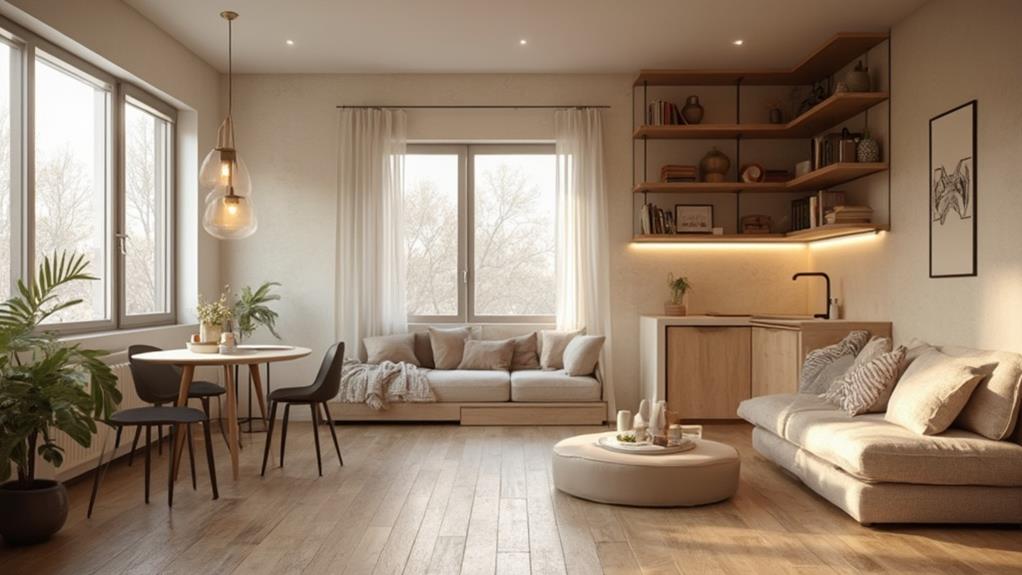Maximizing space in tiny homes on a budget requires creative thinking and smart design choices. Vertical storage solutions like wall-mounted shelving and over-door organizers utilize often-overlooked areas. Multifunctional furniture, such as sofa beds and storage ottomans, serves dual purposes. Intelligent lighting techniques, including layered lighting and strategic mirror placement, can create the illusion of spaciousness. In the kitchen, fold-down tables and vertical storage hacks optimize limited space. DIY organization projects and clever room dividers offer customizable, cost-effective solutions. By implementing these budget-friendly ideas, tiny home dwellers can transform their compact spaces into functional, stylish havens. The possibilities for small space living are truly endless.
Vertical Storage Solutions
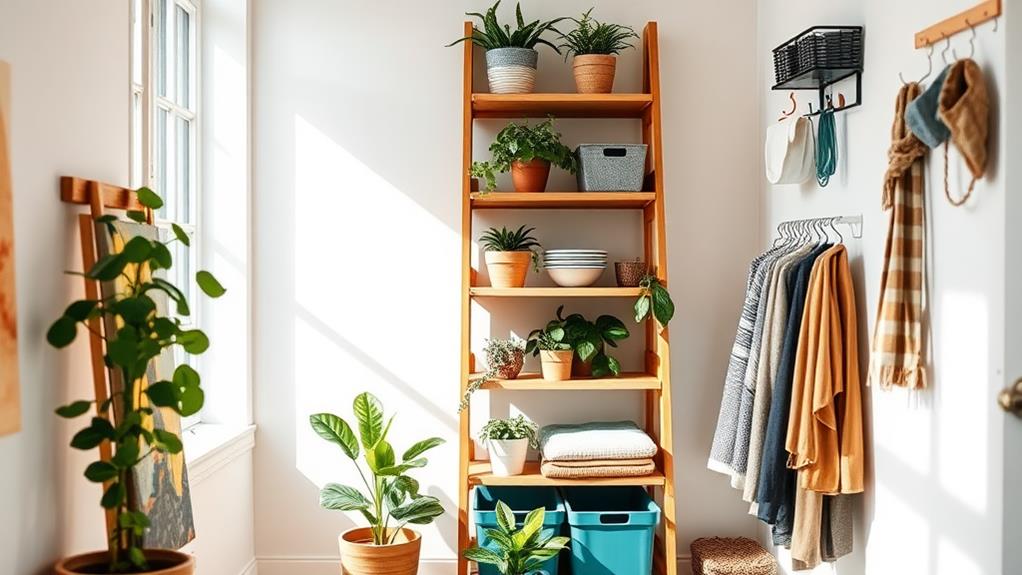
Maximizing vertical space is crucial in tiny homes, where every inch counts. Implementing vertical storage solutions not only helps declutter but also creates an illusion of spaciousness. Wall-mounted shelving units are an excellent budget-friendly option, offering customizable storage for books, decorative items, and everyday essentials. Floating shelves, in particular, provide a sleek look while utilizing otherwise unused wall space.
Consider installing floor-to-ceiling bookcases or built-in cabinets to take full advantage of wall height. These can be DIY projects using affordable materials like plywood or repurposed pallets.
Over-the-door organizers and hanging shoe racks are inexpensive ways to utilize door space for storing small items or accessories.
For kitchens, magnetic knife strips and wall-mounted pot racks free up valuable counter and cabinet space. In bathrooms, vertical towel ladders and over-toilet storage units maximize limited square footage. Utilizing tension rods between walls creates adjustable shelving for lightweight items.
Don't forget about ceiling space – hanging baskets or suspended shelving can store seasonal items or less frequently used belongings. By thinking vertically, tiny home dwellers can significantly increase their storage capacity without breaking the bank.
Multifunctional Furniture Picks
Furnishing a tiny home calls for clever solutions that serve multiple purposes. Multifunctional furniture is essential for maximizing space and functionality in compact living areas.
One popular option is the sofa bed, which provides comfortable seating during the day and transforms into a sleeping space at night. Ottomans with hidden storage compartments offer both seating and a place to stow away items.
Expandable dining tables are another smart choice, allowing for intimate meals or accommodating guests when needed. Wall-mounted desks that fold down when in use and can be tucked away afterward are perfect for creating a temporary workspace. Murphy beds are a classic space-saving solution, freeing up floor space during the day.
For the kitchen, consider a rolling kitchen island that can serve as extra counter space, storage, and a dining table. Nesting tables and stackable chairs are ideal for entertaining, as they can be easily stored when not in use. Lastly, look for furniture with built-in storage, such as platform beds with drawers underneath or coffee tables with shelving, to maximize every inch of available space.
Intelligent Lighting Techniques
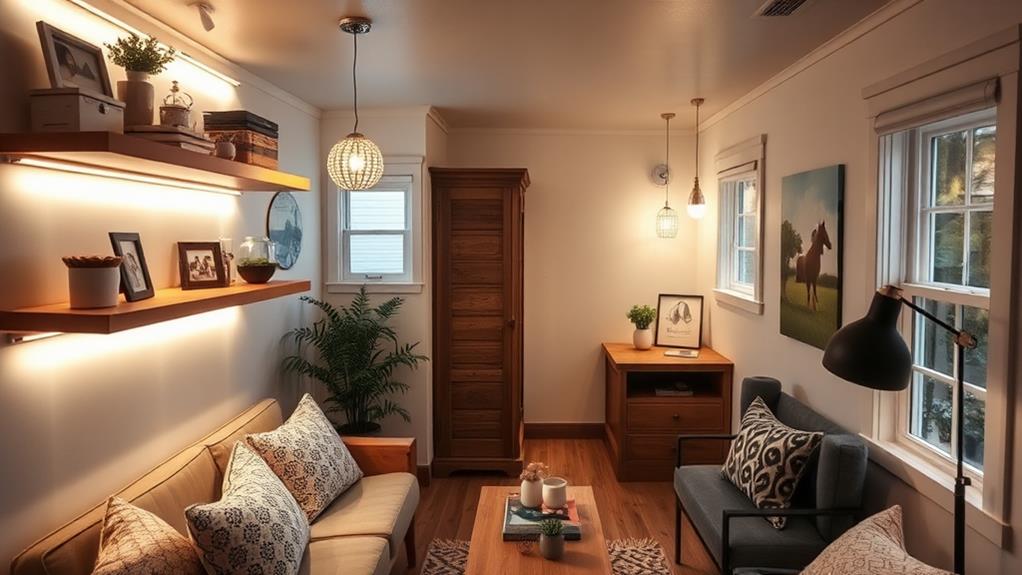
Lighting plays a significant role in creating the illusion of space and enhancing the functionality of tiny homes. Intelligent lighting techniques can transform cramped quarters into open, inviting spaces while staying within budget. Opt for layered lighting, combining ambient, task, and accent lighting to add depth and dimension.
Use wall sconces or pendant lights instead of floor lamps to save valuable floor space. Install dimmer switches to adjust light levels according to time of day and activities.
Maximize natural light by using sheer curtains or blinds that allow sunlight to filter through. Place mirrors strategically to reflect light and create the illusion of more space. LED strip lights under cabinets or along baseboards provide subtle illumination without cluttering surfaces.
Consider smart bulbs that can be controlled via smartphone apps, allowing for easy customization of lighting scenes. Use warm white lights (2700-3000K) to create a cozy atmosphere, and cool white lights (4000-6500K) in work areas for better focus. Incorporate battery-operated, wireless lights for flexibility in placement and to avoid the need for additional electrical outlets.
These intelligent lighting techniques not only enhance the perception of space but also improve the overall livability of tiny homes.
Space-Saving Kitchen Hacks
Efficiency is paramount when designing a kitchen for a tiny home. Maximizing every inch of available space requires innovative solutions and clever organization. Consider installing a fold-down table or countertop extension that can be tucked away when not in use. Utilize vertical space by adding hanging pot racks, magnetic knife strips, and wall-mounted spice racks.
Opt for multi-functional appliances, such as a combination microwave-convection oven or a compact refrigerator with a built-in freezer. Invest in stackable cookware and nesting bowls to minimize cabinet clutter. Install pull-out pantry shelves or drawer organizers to make the most of deep cabinets and hard-to-reach corners.
Create additional storage by using the inside of cabinet doors for hanging small items or installing narrow shelves. Consider a portable induction cooktop that can be stored when not in use, freeing up valuable counter space. Utilize under-sink space with pull-out drawers or tension rods for hanging cleaning supplies. Lastly, choose compact, collapsible versions of kitchen essentials like dish racks, colanders, and cutting boards to further maximize space in your tiny home kitchen.
DIY Organization Projects
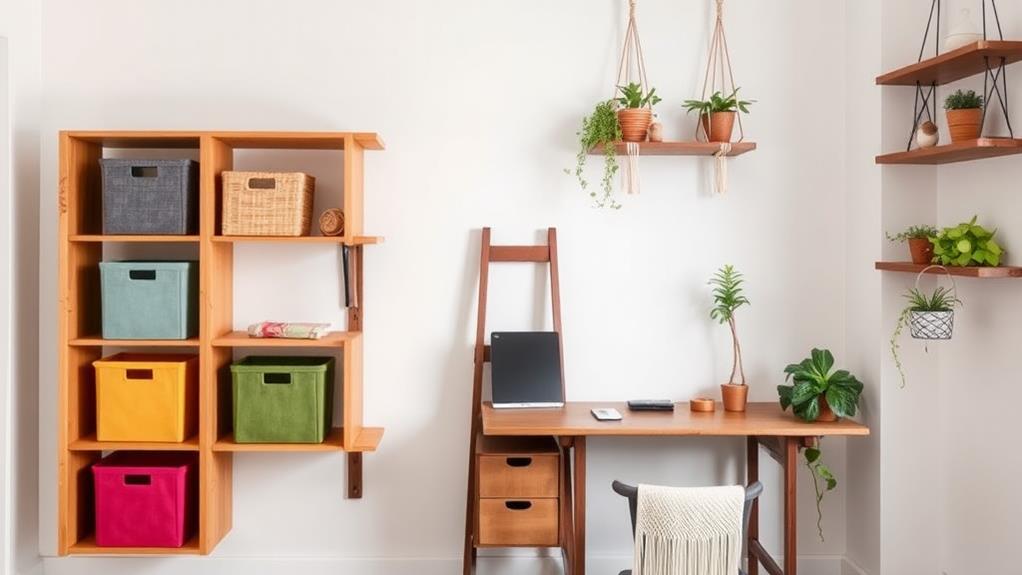
A tiny home's organization can be significantly enhanced through creative DIY projects. These cost-effective solutions maximize space utilization while adding personal flair to your living area. One popular option is creating multi-functional furniture, such as a storage ottoman or a fold-down desk that doubles as wall art when not in use.
Repurposing everyday items can also yield innovative storage solutions; for instance, transforming mason jars into hanging organizers for small toiletries or office supplies.
Vertical space is often underutilized in tiny homes. Installing floating shelves or a pegboard system can provide additional storage without occupying valuable floor space. For clothing storage, consider building a capsule wardrobe system using PVC pipes or constructing a rolling garment rack with reclaimed wood.
In the kitchen, magnetic knife strips and under-cabinet hanging baskets can free up counter space. DIY drawer dividers made from cardboard or wood scraps can help organize smaller items efficiently. Lastly, creating a modular storage system with stackable wooden crates allows for easy reconfiguration as your needs change, ensuring your tiny home remains adaptable and clutter-free.
Clever Room Dividers
Creating distinct spaces within a tiny home can be achieved through clever room dividers that maximize functionality without sacrificing precious square footage. Portable folding screens offer flexibility and can be easily stored when not in use. Repurposed materials like old doors, windows, or pallets can be transformed into unique dividers that add character and charm to the space.
Open shelving units serve a dual purpose as both storage solutions and room separators, allowing light to pass through while defining different areas. Hanging curtains or beaded curtains on tension rods provide an affordable and adaptable option for creating privacy. For a more substantial divide, consider installing a sliding barn door or a retractable accordion-style partition.
Vertical gardens or living walls can act as natural room dividers while improving air quality and adding a touch of greenery. Modular cube storage systems offer customizable configurations that can be adjusted as needs change. Lastly, strategically placed furniture, such as a bookshelf or a console table, can effectively delineate spaces without the need for permanent structures, maintaining an open feel in your tiny home.
Minimalist Decor Strategies
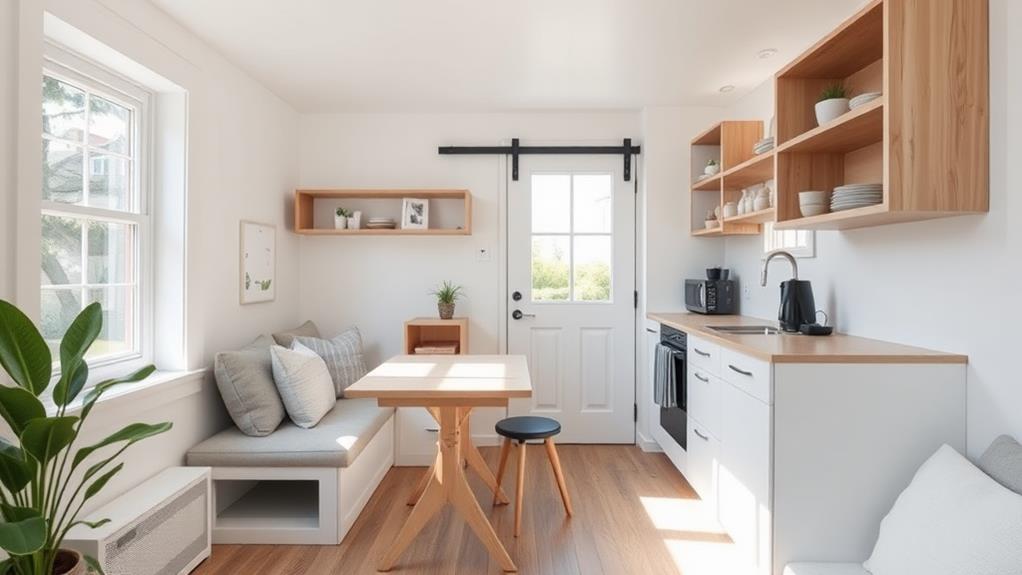
Minimalism's core principles align perfectly with the constraints of tiny home living, making it an ideal decor strategy for compact spaces. By embracing a "less is more" approach, homeowners can create an uncluttered, serene environment that maximizes both physical and visual space.
Start by selecting a neutral color palette for walls and large furniture pieces. Whites, grays, and light earth tones create an open, airy feel. Incorporate texture through natural materials like wood, linen, and jute to add warmth without visual clutter.
Choose multi-functional furniture that serves dual purposes, such as a storage ottoman or a fold-down desk. Opt for sleek, low-profile designs that don't overwhelm the space. Utilize vertical storage solutions to keep floors clear and maintain a sense of openness.
Curate your possessions carefully, keeping only items that are both functional and meaningful. Display a few select pieces of art or decor to personalize the space without creating visual chaos. Use mirrors strategically to reflect light and create the illusion of more space.
Embrace negative space as a design element, allowing areas of emptiness to balance out functional zones. This approach not only makes the home feel larger but also promotes a sense of calm and order.
Hidden Storage Ideas
Storage solutions are the unsung heroes of tiny home living, and hidden storage options take this concept to the next level. By maximizing every nook and cranny, hidden storage helps maintain a clutter-free environment while preserving valuable floor space.
One popular strategy is utilizing under-stair storage. Drawers or pull-out compartments can be seamlessly integrated into staircase risers, providing ample space for shoes, linens, or miscellaneous items. Similarly, hollow ottomans and coffee tables with lift-up tops offer dual functionality as both seating and storage.
Vertical space is often underutilized in small homes. Installing floor-to-ceiling cabinets or shelving units with sliding doors can conceal belongings while creating a sleek appearance. For bedrooms, platform beds with built-in drawers or hydraulic lift mechanisms maximize storage without sacrificing comfort.
In the kitchen, pull-out pantries and retractable countertops can significantly increase storage and workspace. Magnetic knife strips and hanging pot racks free up drawer and cabinet space. Lastly, Murphy beds and fold-down desks are excellent space-saving solutions that can be tucked away when not in use, instantly transforming a room's function and appearance.
Optical Illusions for Spaciousness
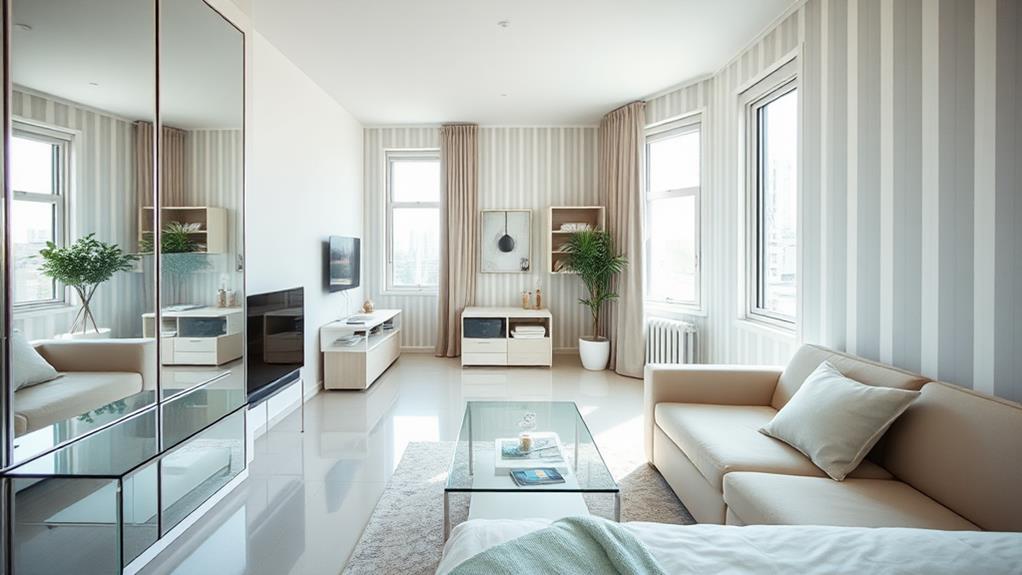
While clever storage solutions can physically maximize space, optical illusions offer a powerful way to make tiny homes feel more expansive. These visual tricks can create the perception of larger rooms without costly renovations.
One effective technique is using light colors on walls and ceilings, which reflect more light and make spaces appear bigger. Painting vertical stripes on walls can also create the illusion of height. Mirrors strategically placed opposite windows amplify natural light and depth, making rooms seem twice their size.
Furniture placement plays a crucial role in spatial perception. Keeping pathways clear and arranging furniture away from walls can create a sense of openness. Multi-functional furniture, such as extendable tables or Murphy beds, maintains flexibility while reducing clutter.
Lighting is another powerful tool. Layered lighting with a mix of ambient, task, and accent lights can define different areas within a single space. Using sheer curtains or blinds allows maximum natural light while maintaining privacy.
Lastly, decluttering and maintaining a minimalist aesthetic can significantly impact perceived spaciousness. Embracing these optical illusions can transform even the tiniest homes into seemingly larger, more comfortable living spaces.
Frequently Asked Questions
How Can I Soundproof My Tiny Home on a Budget?
To soundproof your tiny home affordably, consider using weatherstripping around doors and windows, hanging heavy curtains, installing acoustic panels, using rugs or carpets, and sealing gaps with caulk. For walls, add mass-loaded vinyl or soundproofing foam between studs.
What Are the Best Eco-Friendly Materials for Tiny Home Construction?
Like a forest's balanced ecosystem, eco-friendly tiny homes thrive on harmony. Sustainable materials include reclaimed wood, bamboo, cork, recycled steel, and hempcrete. These options reduce environmental impact while providing durability and insulation for compact living spaces.
How Do I Manage Temperature Control in a Small Living Space?
To manage temperature control in a small living space, consider utilizing multi-functional systems like ductless mini-splits, installing proper insulation, using smart thermostats, and incorporating passive cooling techniques such as strategically placed windows and reflective surfaces. These methods optimize comfort while conserving energy.
Are There Financing Options Specifically for Tiny Home Purchases?
With tiny homes accounting for only 1% of single-family home sales, financing options are limited but growing. Some credit unions offer specialized loans, while RV loans, personal loans, and manufacturer financing are also viable alternatives for tiny home purchases.
What Are the Legal Requirements for Parking or Placing a Tiny Home?
Legal requirements for parking or placing a tiny home vary by location. Generally, you'll need to comply with local zoning laws, building codes, and land use regulations. Some areas may require permits, utility connections, or specific foundation types.
Conclusion
Maximizing space in tiny homes requires creativity and strategic thinking. Vertical storage ascends while multifunctional furniture expands possibilities. Intelligent lighting brightens as space-saving kitchen hacks simplify. DIY projects personalize while clever dividers section. Minimalist decor declutters as hidden storage conceals. Optical illusions expand perceived space, creating an environment that feels larger than its physical dimensions. By implementing these budget-friendly solutions, small spaces transform into functional, aesthetically pleasing havens. The challenge of limited square footage becomes an opportunity for innovative design and efficient living.
